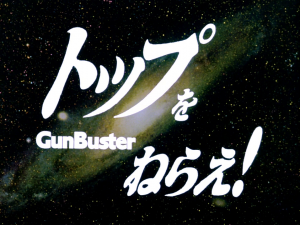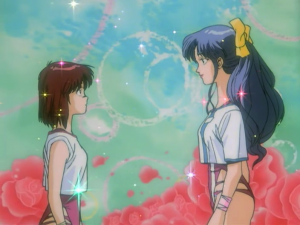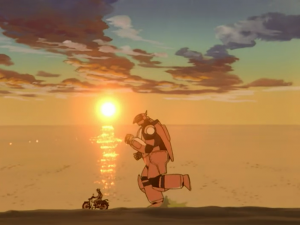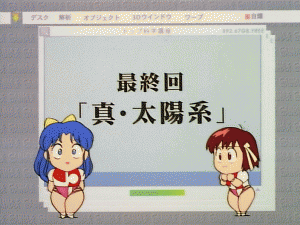To start in on Gunbuster, I’d need to talk about Ken Lau, first. Ken was someone I’d met while working at Acer America back in 1995; we both worked the grave shift in the technical support department, though he was in a smaller group that handled online requests, while I was in a larger group that handled phone calls. Anyway, we met, we hit it off, and thus began a friendship that I still tell stories about to this day. Ken introduced me to a wide range of anime, and I recall that he had a love for one particular anime: Mamono Hunter Yohko. But I’ll talk about Yohko some other time.
Toppu wo Nerae was one of those series that I had little to no information about beforehand. This had a lot to do with the fact that I trusted Ken’s tastes in anime. Nearly everything he put before me to watch, I ended up liking. Gunbuster was no exception to this, in fact, it might be the defining moment. And before I continue on, as I dive back into my memory, I remember how close he and I were before I got married to my first wife, and I regret that we drifted apart. I was in a horrible place then, and I thoughtlessly pushed him away and never heard from him again. It’s one of those times I wish I could go back and change, but I’m sure he’s doing well for himself. But, if he ever happens upon this site and reads this, I want to make sure he knows that I miss him.
Anyway, if you’re completely unaware of Gunbuster, and it seems the Naruto Generation generally is, then let me begin by saying that this is, for all intents and purposes… a parody. A parody of what? Pretty much every giant robot/space pilot story I’d seen to that point. This includes Gundam, Macross, a handful of others. This is a story about a duo of space pilot girls (right away I hooked) of differing ages. The youngest is the lead, Takuya Noriko, the daughter of a famous spaceship admiral who died in combat against a ferocious enemy named only as “Uchuu Kaijuu,” (Space Monsters) when she was eight years old. This story gets going as she’s attending the Okinawa Space Pilot Girls’ High School in order to train and follow her late father into space.
So far, the plot sounds pretty pedestrian, right? Nothing to write home about, and with the additional information of it being a parody (ie: it probably won’t take itself seriously), you’d probably pass on watching it. Well, not so fast. In six episodes, Gunbuster manages to tell a compelling story with surprisingly dynamic characters without resorting to a breakneck pace. If you’ve never seen it, I wholeheartedly recommend that you do. And to prove that it can speak to younger anime viewers, I showed it to my young nephew (20 years old), and he loved it. Head to Bandai’s site and find it, buy it, and enjoy. Tell them I sent you.
Of course, back then, the version I saw was the one released by U.S. Renditions, which was translated by Trish Ledoux & Toshifumi Yoshida. The reason I mention those names is because I had actually met Trish then Toshi on separate years of the same convention (Anime Expo). Crazy as it may seem, I was astonished that both of them remembered me years later (especially Toshi when we ran into each other at Kumoricon in Portland a couple of years ago). I had kept up a lengthy email dialogue with Trish while she was working on Ranma at VIZ. Thinking back on that, I don’t know from where she must have summoned the patience to put up with my incessant questions about anime production and translation work, but she did… and even now, I shake my head and chuckle to myself as I remember months of talking about Ranma and Gunbuster. I honestly don’t know if she remembers those emails or not, but I do. It was amazing to get that perspective on how anime is produced and really opened my eyes. So, a special thanks to them for being so kind to me when I was 18 and learning about anime. It heightened my appreciation for the work done on both sides of the Pacific.
Back to the story of the anime itself… Noriko’s sempai is Amano Kazumi, whom everyone refers to as “Onee-sama.” They meet, and Onee-sama gives some very encouraging words to Noriko, after she’s been mistreated by some of the closed-minded students who think less of her because of her father. Kazumi is considered a shoe-in for one of the two slots for a special space program (The Machine Weapon Advance Assault Squadron, aka the “Top”). And to choose those two lucky students, is Coach Ota. He appears on the scene in dramatic fashion, with his sharp, no-nonsense tone and his strict regimen of exercising the students. When Noriko fails to execute his command, he shuts off her RX-7 machine and makes her run laps on her own two feet to the amusement of the rest of her class.
The conflict for the first episode comes when Noriko is selected along with Kazumi for that special program. The entire school is turned on its ear as no one can figure out why Noriko was selected. Then, the accusations fly: Obviously, because she is the daughter of Admiral Takuya, she got special treatment from the Coach. Even Kazumi’s surprised that Noriko was chosen. Kazumi wanted Kashihara to go with her. But Coach is adamant that Noriko was the right choice, and tells Kazumi to shove it. After all, he decides who goes and who stays, not her. But it’s clear from the scene, their discussion alludes to a deeper relationship than instructor and student. More on that later…
Noriko (with her friend, Kimiko) is now training harder, but simply being there is difficult enough. The other students have marked up the announcement with libelous remarks about her, they covered her RX-7 machine in graffiti with unkind things, and to put the cherry on the sundae, a sharp thumbtack was waiting for her scantily-clad rear end when she sat down to pilot said machine. This drives her tears and she approaches Coach to reconsider his selection. It’s one of those pivotal character moments, when Coach convinces Noriko to stay the course. He uses Kazumi as an example of how hard work and disciplined training could turn her from an inept pilot to a skilled one. He even shows her how Kazumi trains, and then Noriko gets the determined shine in her eyes.
Coach helps her train and soon she becomes skilled enough in her RX-7 to do pretty anything she could do with her own body. She does push-ups, lifts things, and runs along Coach on his little scooter against a scenic sunset on the beach. She has grown into that selection of being sent into space ahead of her peers, and Coach is proud of her accomplishment. But, Kashihara isn’t too happy and she tells Coach that she feels she’s superior to Noriko. Coach tells her he doesn’t answer to her, and even Kazumi says that Kashihara is acting unseemly. Well, Kashihara with the crazy eyes and unseemly behavior decides to take matters into her own hands and challenges Noriko to a straight-up fight between their RX-7 machines.
In the beginning, Kashihara is wiping the floor with Noriko using some strange tactics. At one point, she even slaps the head of Noriko’s RX-7 machine as though it were a bare-fisted match. Anyway, Noriko’s machine is now down in a supine position, and Kashihara is just stomping the shit out of the chest of Noriko’s robot. There’s a kind of a “Use the Force, Luke” moment with Noriko whiles she’s being rattled inside like a pea in a tin can and she decides to turn off all of her monitors so she can’t see what’s going on. This impresses Kazumi, Coach is dispassionate, and for some reason this totally enrages Kashihara. In a dick move, she decides that now is the time for the Mortal Kombat “Finish Her” move and whips out a long blade with the intent of totalling Noriko’s ride. Noriko, on the other hand, somehow senses this and when Kashihara’s blade comes down, she jumps up with her machine out of harm’s way and does an acrobatic maneuver. Noriko rights herself and brings the leg of her machine down while screaming, “Inazuma Kick!” The kick is the deciding blow, as Kashihara is now sitting in the remains of her machine with the realization that Coach was right. Noriko’s selection is now no longer in question and she and Kazumi board a shuttle to take them to the orbiting space station where they will be working from now on.
I don’t do the actual story justice, and if I seem like I’m belittling the anime it’s not because I hate it. I guess, while rewatching the first episode I forgave a lot of the absurdities of the parody part of the show. I feel that you have to in order to let the story take you where it wants to go, but trust me when I say that the show will not disappoint you. By the time I got tot he end of the sixth episode, I was a mess. I was crying openly, and just left there to try and compose myself. Any story, written or acted, if it invokes an emotional response then the production has reached me.
I want to take a moment to acknowledge the seiyuu. Noriko and Kazumi were played by seiyuu from Ranma Nibunnoichi, Hidaka Noriko (Tendou Akane) and Sakuma Rei (Shampoo), respectively. Coach Ota’s voice came from Wakamoto Norio (Oskar von Reuenthal from Ginga Eiyuu Densetsu, among many many others). If I were to use any anime to state my preference of why I love the Japanese seiyuu over North American voice acting, Gunbuster could quite possibly be my Exhibit A. I cannot imagine any English-speaking actor to pull off the passion and emotion equal to the Japanese voice track. There are rare occasions where I might prefer English over Japanese (Ranma, Taihou Shichau zo!), but that’s about it.
Gunbuster was directed by Anno Hideaki, who needs no introduction. But, just in case he does, he was the creative force behind several Gainax projects, including Fushigi no Umi no Nadia and Kareshi Kanokyou no Jijyou, but most notably, Evangelion. I should also point out that he worked as an animator for the original Macross series, and was the animation director for Oritsu Uchuugun: Honneamise no Tsubasa (The Wings of Honneamise).
Kouhei Tanaka composed a brilliant score for Gunbuster. In my opinion, I think he’s as good a composer as Kanno Yoko (Escaflowne, Macross Plus/Frontier) or Shiro Sagisu (Kare Kano, Evangelion). Maybe not quite as spectacular as Hisaishi Joe (of Studio Ghibli fame), but nonetheless, his score for Gunbuster lives in my memory as helping to make the whole show as powerful as it is. If, by chance, you get a chance to watch Gunbuster, I invite you to pay special attention to how stirring the music is as the scenes play out. There is no question in my mind that the ending would be as impacting without that gorgeous track, “Toki no Kawa wo Koete…” (“The End of the Endless River”) playing underneath it all. Like so many other anime, the music is essential and necessary to everything the story is trying to do here, and I can point to that last episode and present it as an essential example of why I love the music of anime as much as the anime itself. Of course, personally being a musician helps my appreciation of that aspect of any visual media, not just anime.
In addition to being a great story, Gunbuster also had a series of shorts to explain the science behind the technology and the history of the war between the humans and the Uchuu Kaijuu. It was hosted by super-deformed versions of Noriko, Kazumi, and Coach and managed to make me laugh as Noriko played the dunce and Kazumi the straight man of the duo. I especially loved the part where Noriko’s going through the planets of the solar system and changing costumes to the various senshi of Sailor Moon as she does so. Obviously, Sailor Stars hadn’t come out, yet, because she only does the inner senshi. When she moves to naming the planets of the outer solar system, thee’s no Sailor Jupiter, Saturn, etc.
The point of the shorts is to flesh out some of the reasoning behind why Noriko and Kazumi would never grow as old as their peers that remained on Earth, thanks in part to Einstein’s theory of Relativity. During our email chats, I recall Trish telling how difficult it was to translate those shorts because of all the heavy technical talk (I think). Even now, after my brief Japanese courses at Foothill, I could hear some of the language used and try to sound it out, but it was way way way above my level of understanding. So, thanks Trish and Toshi, for all that hard work!
In summary, Gunbuster remains one on a list of anime that will be with me until I die. I just wish that I held onto my original U.S. Renditions version… but along with several other tapes I had in storage, it was damaged beyond repair when a storm of mice ate several boxes. Apparently, our next door neighbor in the storage place was keeping food and it attracted vermin for miles until he got evicted. I lost a box of old anime tapes when they chewed through them and actually managed to chew the cases up pretty bad, rendering them unable to play. I nearly cried when I was informed.
Anyway, this ends yet another post about anime from me. If I have time, I’ll try to work on another one. I would love to hear from you all on your thoughts on Gunbuster, in the comments here or on Facebook, where this will get cross-posted. Thanks!














1 ping
[…] round the same time that I was running through Maison Ikkoku, the previously-mentioned Ken Lau introduced me to another series that had piqued my interest. Maison Ikkoku was a rather […]